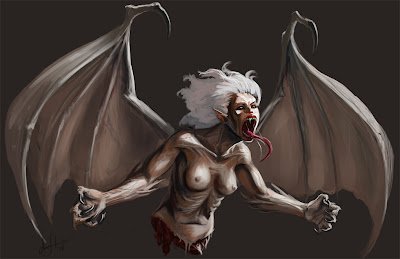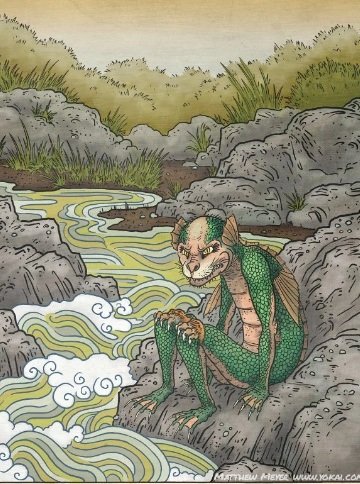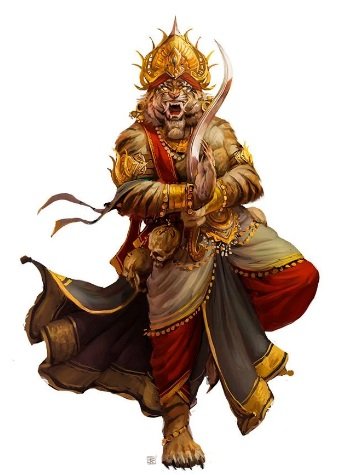Vampire Folklore Series: The 10 Horrors of Asia
In this part of our vampire folklore series, we’ll delve into some of the vampire legends that come from Asia.
While the Eurocentric view of vampires in popular media tells tales of strong, charismatic, almost anti-hero vampires, the original folklore is often much darker, and none more so than on the Asian continent. Their vampire folklore tells the stories of hideous monstrosities that seek to drain the blood of the living to sustain themselves.
The Manananggal
Image from The Demonic Paradise
The Manananggal is a mythical creature born directly from someone’s nightmares. According to the people of the Philippines, where this creature haunts, they are flying terrors that stalk the night seeking victims to feed upon.
It is said that they are usually female and have the ability to split in two, venturing into the night sky borne upon great bat-like wings in search of prey, their favourite being sleeping pregnant women.
Once the Manananggal has located a suitable victim, it will descend to feed upon the unfortunate person, using a proboscis-like tongue to suck the victim dry of blood, including the baby inside its mother’s womb. Truly monstrous.
There are also regional versions of this mythical tale, with a similar story coming from the Capiz region, where the creature is referred to as a Mandurugo. The Mandurugo also feeds on victims using a proboscis-like tongue but is apparently unable to split its body in two. Instead, it will often marry into a village to feed on clueless husbands.
The Kephn
Image from Dracula Van Helsing
In the Asian country of Myanmar, folklore tells of a demonic vampire born of dark magic. The Karen people of Myanmar know this creature as a Kephn, and horrifyingly, it is described as a flying head with exposed entrails.
The Kephn is believed by these people to be the nocturnal form of dark sorcerers looking to feed in the night or expand their revenant servants. The Kephn is believed to stalk the night, looking for victims before descending on them and hungrily feeding on their souls. It is even said that the Kephn can transfer an ingested soul into the dead body of another in order to create zombie servants for the sorcerer.
The Kephn is a particularly interesting monster of folk tales as its flying head resembles that of several other Asian monsters of vampire folklore. The fact that it feeds on souls is slightly different to the usual vampire lore, although many tales of vampires suggest they feed on the lifeforce of the living, be it the blood or their soul.
It is said that the Kephn is extremely difficult to kill during the night, thanks in part to their ability to fly, and that attacking the sorcerer in the day while they are mortal is the best way to dispose of the creature.
The Langsuir
Image from Wikipedia
A similar monster exists in the folklore of Malaysia, where their people tell stories of a Langsuir or Langsuyar. These monsters are vampires born from the vengeful spirits of Malaysian women who die during childbirth.
In some of the stories, the Langsuir appear as women with beautifully long hair and unusually long fingernails. They descend on the living to prey on their favourite meal – newborn babies, particularly males, draining them of blood to sustain themselves.
Interestingly, there are also variations of the Langsuir myth that describe it as a flying head with an exposed spinal cord, drawing notable similarities to the Kephn of Myanmar. The people of Malaysia agree on one thing, though, and that is that if you encounter a Langsuir, you should not hesitate to run as fast as you can.
The Penanggalan
Image from Sarah Connell
Another Malaysian vampire folklore myth comes in the form of the Penanggalan, which conforms to the other vampires we have seen so far. The Penanggalan is a ghastly Asian vampire that appears as the head of a woman, flying with its entrails exposed.
Similar to the Kephn and Langsuir in appearance, the Penanggalan is born by the supernatural acts of witches. It hunts in the night, seeking its favourite prey, once again, pregnant women or women in childbirth. Once it has located a suitable meal, the Penanggalan hides under the stilts of the house and feeds off the mother using its unnaturally long tongue. While the creature feasts on the blood of the mother, the mother would often present as though suffering from a wasting disease.
Luckily, the Penanggalan does seem to have several weaknesses. The severed floating head is actually said to be the dismembered head of the witch themselves, and their headless bodies lie dormant, waiting to be reunited. As such, it’s possible to destroy the body by burning it or pouring glass into the open wound, preventing the head from reattaching, which would result in death as the sun rises.
For those too fearful or who cannot locate the body, thorny boughs can be scattered under the house, which damages the exposed entrails of the Pananggalan as it lurks.
The Leyak
Image from Wikipedia
A creature similar to the Penanggalan is the Leyak of Indonesian folklore. The Leyak are the vampiric forms of black magic practitioners that have a taste for human blood. They appear with long tongues and fangs and are said to have shapeshifting abilities.
The Leyak’s favourite prey is the blood of unborn children and babies. However, they are known to inhabit graveyards and eat the flesh of corpses when necessary.
They are particularly feared among Balinese people because they look like a normal person during the day, so they are difficult to spot. However, as with many Asian folk tales, during the night, the head and entrails break free from their body, flying through the night in search of more prey.
Leyaks are supposedly the followers of one of the most powerful and feared entities in Indonesian folklore, the widow-with Rangda, the eternal enemy of Barong, the king of the spirits.
The Suiko
Image from Mythus Fandom
While Japan is mostly devoid of vampire-like creatures, there is one that does fit the bill in most ways. The Suiko or ‘Water Tiger’ are similar to another Japanese creature, the Kappa, who are reptilian-like demons.
However, the Suiko are far uglier and more violent than the Kappa. In some Japanese myths, the Suiko are the spiritual leaders of the Kappa and can lead large bands of them.
Suikos are fond of dragging their human victims into rivers or lakes, where they drain them of blood and feast on their souls, which does sound fairly vampiric. Where the Suiko myth differs, however, is that they appear to do this purely to appear strong to their Kappa minions rather than to sustain themselves, which is often not seen in vampire lore.
The Jiang Si
Image from Taipei Times
In China, the vampire is known as Jiang Shi, or, more commonly, the Chinese hopping vampire. There are apparently many ways in which a Jiang Shi can be created, including the supernatural resurrection of a corpse, supernatural possession of a person, or the inability of a person’s soul to depart their body upon death due to an unnatural passing.
The Jiang Shi’s appearance is more in keeping with the traditional view of a zombie, including stiffness in the legs and an outreaching set of arms, the former causing the creature to appear to bounce or jump forward, hence the name.
The appearance of the skin will depend on the means of creation; possession will leave a vampire looking more or less human, but reanimation will depend on the state of the corpse.
The Jiang Shi rests in coffins during the day and emerges at night to feed on the qi or life essence of the living. This, in particular, draws fascinating similarities to the European idea of a vampire.
In Asian vampire folklore, the Jiang Shi are said to be frightened by their own reflection, so mirrors can be used to combat one, as well as fire, decapitation, vinegar, the blood of a black dog, and the hooves of a black horse. European Vampire lore has influenced the Jiang Shi more recently, and blood-sucking traits over life-force feeding have begun to seep into the myths.
The Rakshasas, Vetalas & Pishachas
Image from The Demonic Paradise
Finally, there are several beings in Indian folklore that could have origins in or stemmed from part of the vampire myth. Those beings are the Rakshasas, Vetalas, and Pishachas.
All these beings are demonic entities that can inhabit human form and are said to be fond of the flesh and blood of the living. So, it’s no surprise that they may have helped spur on vampire mythology as they are often accused of reanimating humans or corpses to feed.
Final Thoughts
Asian vampire folklore is perhaps more gruesome and disturbing than some of the other Vampire lore around the world. Many of the stories centre around preying on pregnant women or children, which differs somewhat from the Eurocentric view of the romanticised and charismatic vampires we are used to today.



















